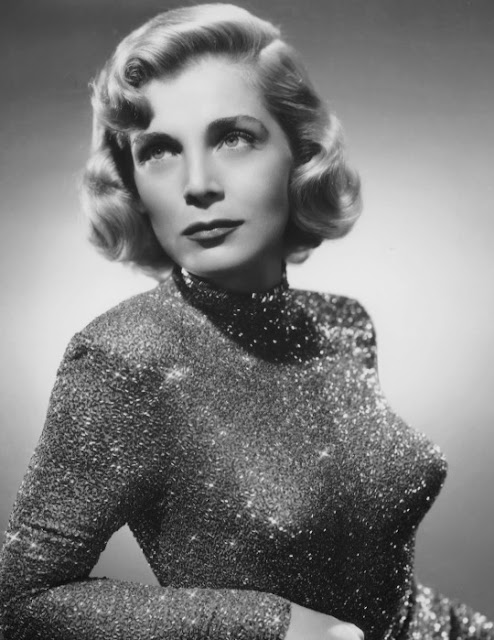Flame of the Islands (1956) shares the same
basic premise as many another fun kitschy film: a brassy libidinous good-time
girl (usually some variation of “nightclub singer”, which is Old Hollywood shorthand
for “scarlet woman”) rocks-up in some torrid exotic locale and her mere
presence - and disruptive sexuality - can’t help but wreak havoc. Think of Marlene Dietrich in Seven Sinners (1940), Rita Hayworth in Miss Sadie Thompson (1953) or
any number of Jane Russell vehicles like His Kind of Woman (1951), Macao (1952)
or The Revolt of Mamie Stover (1956).
In fact, it’s easy to picture Russell in
the lead role in Flame of the Islands, a lurid 1956 melodrama via poverty row Republic
Pictures. (Synopsis: "An ambitious, sultry cabaret singer invests in an
upmarket club in the Bahamas and tries to rekindle an old romance"). But I’m
glad the part went to that other sublime atomic-era brunette sex goddess Yvonne DeCarlo (the future Lily Munster),
who had comparatively fewer opportunities to shine than Russell. Flame certainly
makes for a persuasive showcase for DeCarlo’s allure. She’s a tough,
sensual and glamorous presence as hard-boiled heroine Rosalind Dee. DeCarlo
gets to sing (she has two high-camp calypso musical numbers, one of which is
entitled “Bahama Mama”), emote (including a convincing drunk scene), carry the
burden of a painful secret in her past (she has multiple identities: Rosalind
Dee is really Linda Darcy!), fight-off unwanted romantic overtures from
multiple men (seen today, these look alarmingly like sexual harassment) and tenaciously pursue
the man she really loves, complete with spectacular wardrobe changes (watch for
a fluffy white angora sweater that Ed Wood Jr would covet).
/ French language poster for Flame of the Islands (1956) /
/ Zachary Scott and Yvonne DeCarlo in Flame of the Islands (1956). Photo via /
And Flame is filmed in Republic Studio’s
signature glorious Trucolour process, the poor man's Technicolour. (If you’ve
seen Nicholas Ray’s perverse and operatic 1954 Western Johnny Guitar, you’re au
fait with the wonders of Trucolour). The better-than-life colours (like the
blue of a swimming pool, DeCarlo’s ice-pink dress) really sizzle. In fact, for
a relatively low-budget film, Flame is a gorgeous viewing experience. Because
the action is set in the Bahamas there are lots of heavenly bamboo Tiki moderne-style
interiors (DeCarlo's minimalist bungalow is all rattan furniture, tropical
prints, sprays of gladioli and a jungle of cheese plants). And some of the action takes place over Christmas,
so you get to see what tropical Tiki mid-century Christmas decor is like. (Watch
for the silver aluminum tree). Even though the main characters seemingly spend
a hell of a lot of time in front of "green screens" (and when they
get in a car, it's rear projection a-go go), Flame was definitely filmed on
location in Bahamas, which makes for a sun-kissed and idyllic backdrop.
/ Photos via /
It must be noted: Flame is a product of its
era. For a film set in the Bahamas, it’s entirely apathetic about the actual
Bahamian populace, who are confined to the margins in servile roles - usually carrying
a tray of cocktails - throughout. I cringed when DeCarlo’s housekeeper (filmed
from behind) warns her about the dangers of voodoo. The only time we see black
faces in close-up is when a group of adorable little black boys sing “Yes Jesus
Loves Me” at a church service on the beach. And of course, when DeCarlo warbles
her calypso numbers she adopts faux-Jamaican patois - cultural appropriation
alert!
/ Rosalind scandalizes the snobby local blue bloods by bustin' out a raunchy musical performance at the Christmas cocktail party! /
/ Above: Yvonne DeCarlo and Howard Duff in Flame of the Islands /
Howard Duff is pallid as Doug Duryea, the rich
boy from an entitled old money background who broke DeCarlo’s heart years before
years - and who she yearns to reunite with. The reliably intense character actress Barbara
O'Neil (aka Scarlett O’Hara’s mother in Gone with the Wind) wrings maximum
drama from every second she’s onscreen as Duff’s heart attack-prone, needy and
neurotic socialite mother Charmaine. Of course, Charmaine is mortified that her
son is entangled with a disreputable nightclub chanteuse with a scandalous past.
There are delicious incidences where her hoity toity high society matron
friends give DeCarlo horrified, disapproving “well I never!” glares.
/ You might remember scene stealer par excellence Barbara O'Neil from supporting roles (usually as brittle, bitchy mothers) in films like All This and Heaven Too (1940) and Angel Face (1952) /
Lanky James Arness is ruggedly handsome as
Reverend Kelly Rand (those broad shoulders! Those tousled blond curls! That
lantern jaw!). The scene where Kelly takes DeCarlo marlin fishing on his boat -
with blatantly fake and mismatched use of stock footage - is one of Flame’s
kitsch highlights. Best of all, that consummate lounge lizard and mustache
role model Zachary Scott plays Wade Evans, DeCarlo’s gay best friend who tags
along for the adventure. At least, that’s how Wade comes across in Scott’s
campily indolent performance. Watch for Scott’s sartorial zenith in one
sequence where he lounges in a red-and-white striped Breton shirt with pink
trousers. Fiercely chic! With its jolting lurches in tone and unexpected narrative twists (there's an entire confusing organized crime subplot I haven't even touched on),
Flame of the Islands represents the irresistible acme of juicy, pulpy and garish
fifties b-movie melodramas. It hypnotized me into a trance of pleasure!
Watch Flame of the Islands here! But remember ...
... it's not suitable for children!






























































